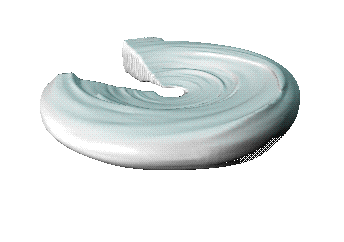

Tidally-induced spiral waves may efficiently
transport angular momentum out of the disk
so that gas can fall into the black hole.
Parallelization was achieved by breaking up
the 3D disk model into 2D planes, with each plane computed on a
different processor. Evolution in the direction around the disk is computed locally
on individual processors after the data is transposed across
processors with a single MPI_ALLTOALL call.
We use time-dependent hydrodynamical simulations of an
isothermal accretion disk to measure
the effects of binary tidal forces on transport within an accretion disk.
Our initial 3D simulation was run for half a million timesteps on a grid
of 200 x 120 x 120 zones, requiring 100 hours on 120 processors using the IBM SP.
